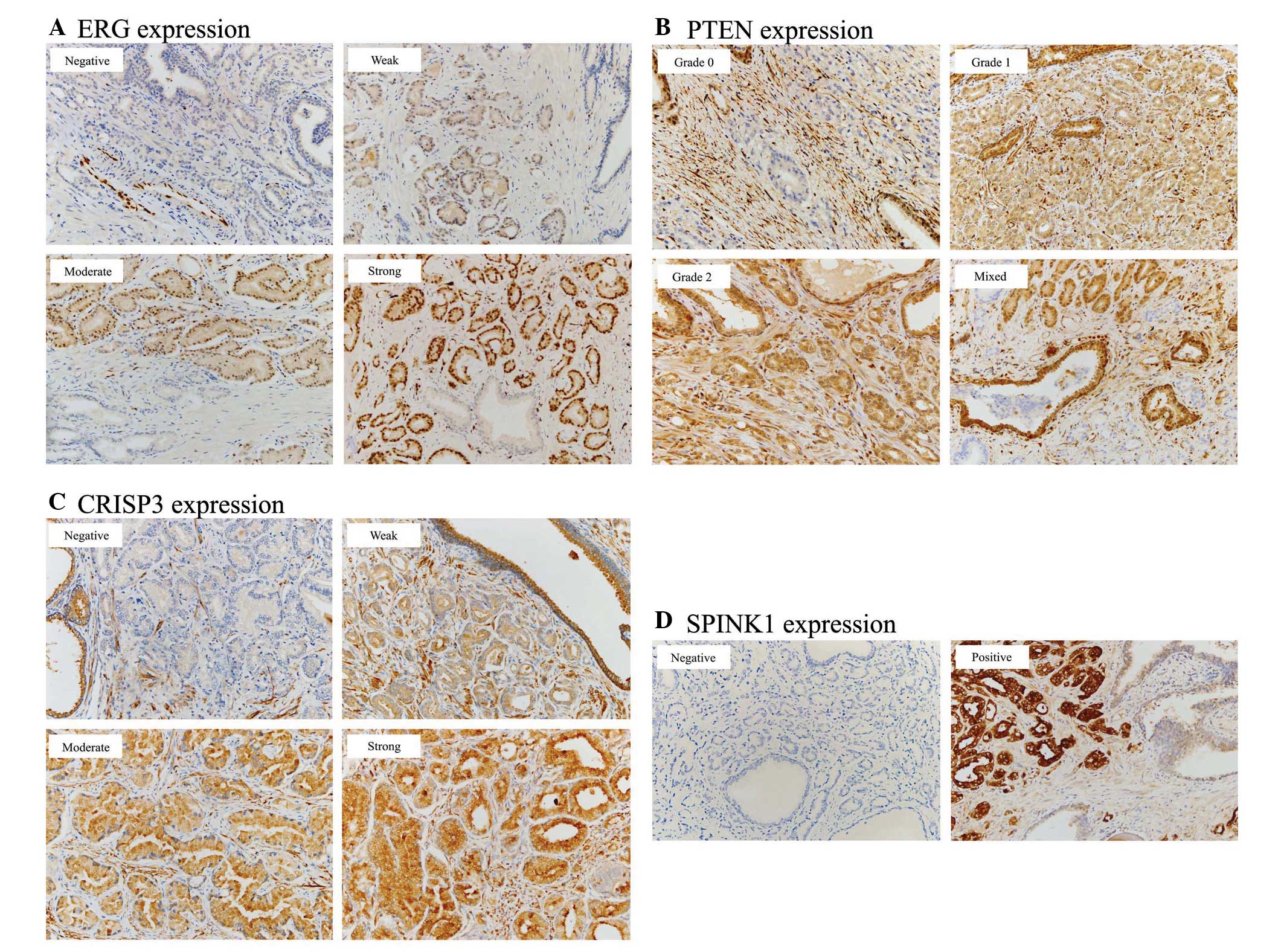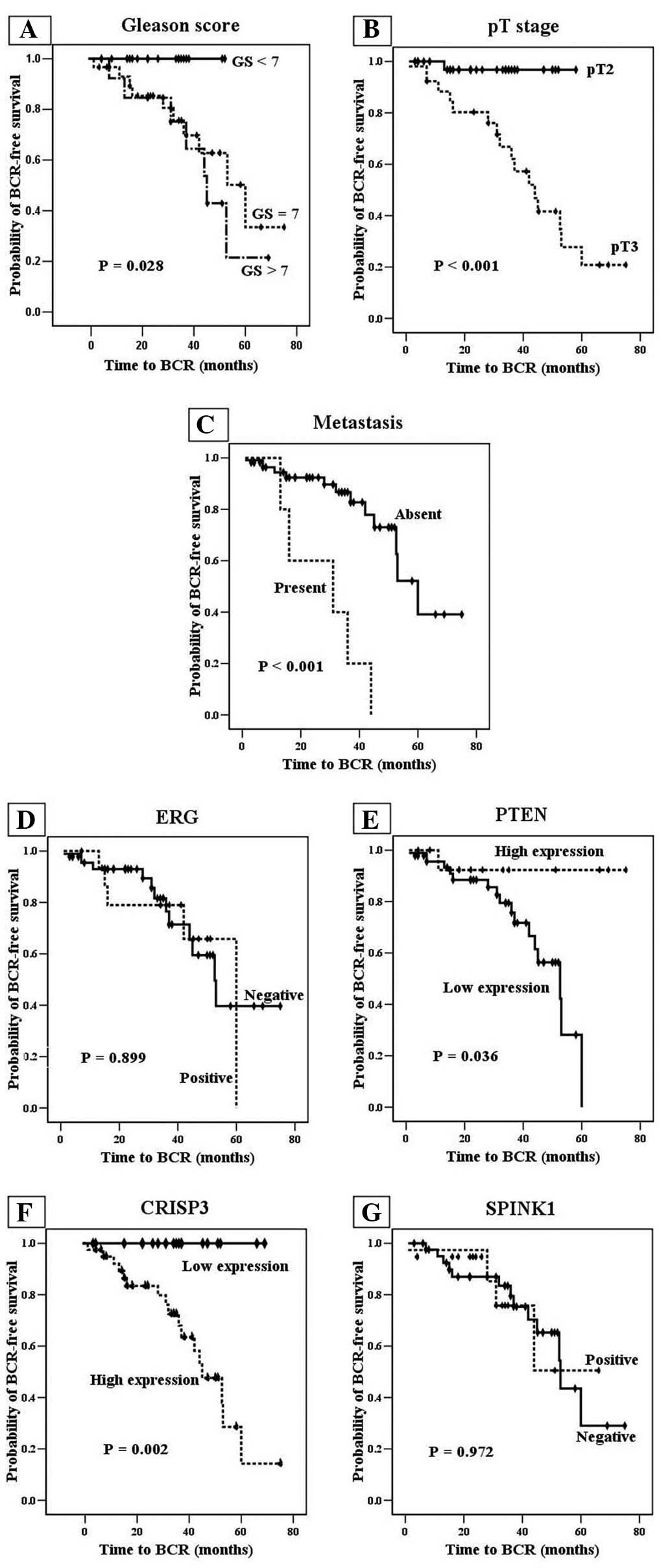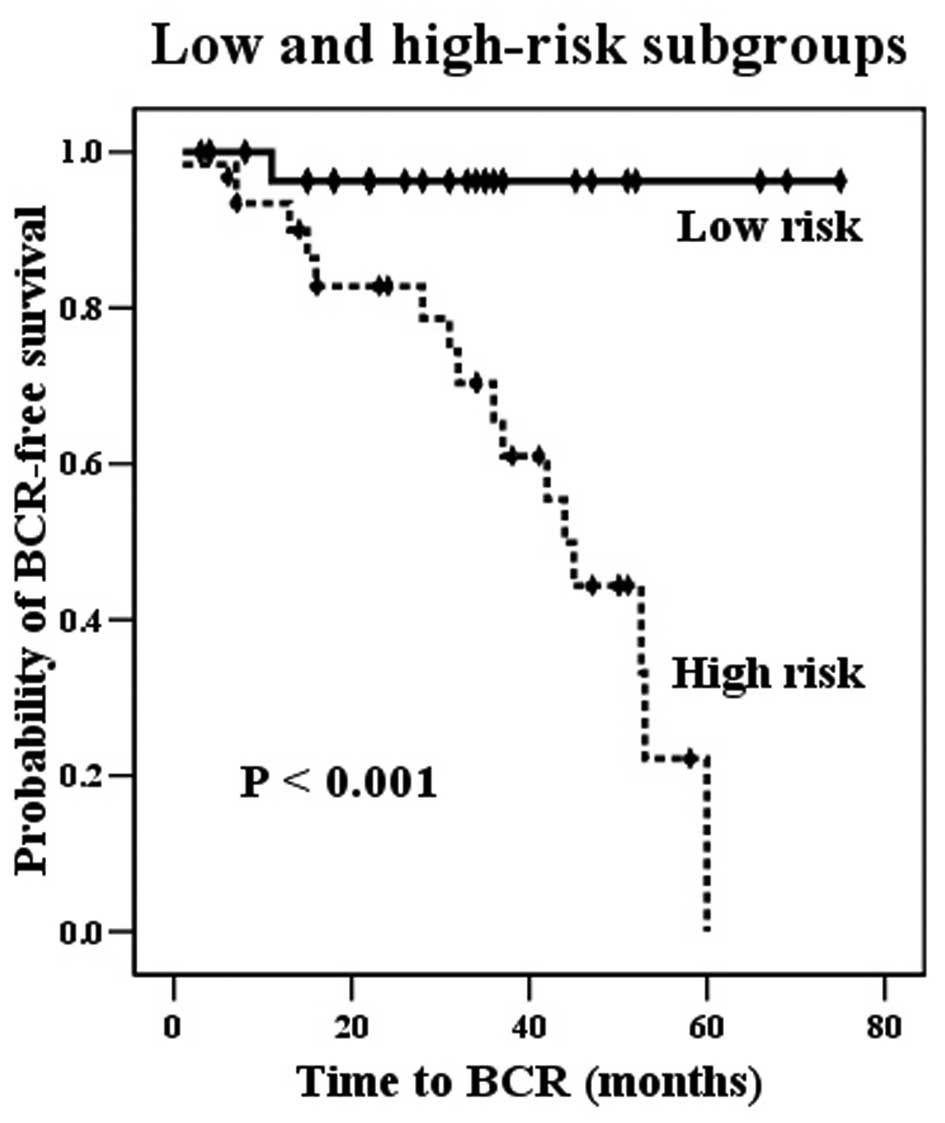|
1
|
Lee K, Chae JY, Kwak C, Ku JH and Moon KC:
TMPRSS2-ERG gene fusion and clinicopathologic characteristics of
Korean prostate cancer patients. Urology. 76:1268.e7–1268.e13.
2010.
|
|
2
|
Jemal A, Bray F, Center MM, Ferlay J, Ward
E and Forman D: Global cancer statistics. CA Cancer J Clin.
61:69–90. 2011. View Article : Google Scholar : PubMed/NCBI
|
|
3
|
Siegel R, Ma J, Zou Z and Jemal A: Cancer
statistics, 2014. CA Cancer J Clin. 64:9–29. 2014. View Article : Google Scholar : PubMed/NCBI
|
|
4
|
Cuzick J, Yang ZH, Fisher G, Tikishvili E,
Stone S, Lanchbury JS, Camacho N, Merson S, Brewer D, Cooper CS, et
al: Prognostic value of PTEN loss in men with conservatively
managed localised prostate cancer. Br J Cancer. 108:2582–2589.
2013. View Article : Google Scholar : PubMed/NCBI
|
|
5
|
Liu W, Xie CC, Thomas CY, Kim ST, Lindberg
J, Egevad L, Wang Z, Zhang Z, Sun J, Sun J, et al: Genetic markers
associated with early cancer-specific mortality following
prostatectomy. Cancer. 119:2405–2412. 2013. View Article : Google Scholar : PubMed/NCBI
|
|
6
|
Van der Kwast TH: Prognostic prostate
tissue biomarkers of potential clinical use. Virchows Arch.
464:293–300. 2014. View Article : Google Scholar : PubMed/NCBI
|
|
7
|
Edge S, Byrd DR, Compton CC, Fritz AG,
Greene FL and Trotti A: AJCC Cancer Staging Handbook (7th).
Springer-Verlag. New York, NY: 2010.
|
|
8
|
Epstein JI, Allsbrook WC Jr, Amin MB and
Egevad LL: ISUP Grading Committee: The 2005 international society
of urological pathology (ISUP) consensus conference on gleason
grading of prostatic carcinoma. Am J Surg Pathol. 29:1228–1242.
2005. View Article : Google Scholar : PubMed/NCBI
|
|
9
|
Cuzick J, Fisher G, Kattan MW, Berney D,
Oliver T, Foster CS, Møller H, Reuter V, Fearn P, Eastham J, et al:
Long-term outcome among men with conservatively treated localised
prostate cancer. Br J Cancer. 95:1186–1194. 2006. View Article : Google Scholar : PubMed/NCBI
|
|
10
|
Punnen S, Cooperberg MR, D'Amico AV,
Karakiewicz PI, Moul JW, Scher HI, Schlomm T and Freedland SJ:
Management of biochemical recurrence after primary treatment of
prostate cancer: A systematic review of the literature. Eur Urol.
64:905–915. 2013. View Article : Google Scholar : PubMed/NCBI
|
|
11
|
He H, Magi-Galluzzi C, Li J, Carver P,
Falzarano S, Smith K, Rubin MA and Zhou M: The diagnostic utility
of novel immunohistochemical marker ERG in the workup of prostate
biopsies with ‘atypical glands suspicious for cancer’. Am J Surg
Pathol. 35:608–614. 2011. View Article : Google Scholar : PubMed/NCBI
|
|
12
|
Qi M, Yang X, Zhang F, Lin T, Sun X, Li Y,
Yuan H, Ren Y, Zhang J, Qin X and Han B: ERG rearrangement is
associated with prostate cancer-related death in Chinese prostate
cancer patients. PLoS One. 9:e849592014. View Article : Google Scholar : PubMed/NCBI
|
|
13
|
Dahlman A, Rexhepaj E, Brennan DJ,
Gallagher WM, Gaber A, Lindgren A, Jirström K and Bjartell A:
Evaluation of the prognostic significance of MSMB and CRISP3 in
prostate cancer using automated image analysis. Mod Pathol.
24:708–719. 2011. View Article : Google Scholar : PubMed/NCBI
|
|
14
|
Al Bashir S, Alshalalfa M, Hegazy SA,
Dolph M, Donnelly B and Bismar TA: Cysteine- rich secretory protein
3 (CRISP3), ERG and PTEN define a molecular subtype of prostate
cancer with implication to patients' prognosis. J Hematol Oncol.
7:212014. View Article : Google Scholar : PubMed/NCBI
|
|
15
|
Bhalla R, Kunju LP, Tomlins SA,
Christopherson K, Cortez C, Carskadon S, Siddiqui J, Park K,
Mosquera JM, Pestano GA, et al: Novel dual-color
immunohistochemical methods for detecting ERG-PTEN and ERG-SPINK1
status in prostate carcinoma. Mod Pathol. 26:835–848. 2013.
View Article : Google Scholar : PubMed/NCBI
|
|
16
|
Hermans KG, van Marion R, van Dekken H,
Jenster G, van Weerden WM and Trapman J: TMPRSS2:ERG fusion by
translocation or interstitial deletion is highly relevant in
androgen-dependent prostate cancer, but is bypassed in late-stage
androgen receptor-negative prostate cancer. Cancer Res.
66:10658–10663. 2006. View Article : Google Scholar : PubMed/NCBI
|
|
17
|
Saramäki OR, Harjula AE, Martikainen PM,
Vessella RL, Tammela TL and Visakorpi T: TMPRSS2:ERG fusion
identifies a subgroup of prostate cancers with a favorable
prognosis. Clin Cancer Res. 14:3395–3400. 2008. View Article : Google Scholar : PubMed/NCBI
|
|
18
|
Miyagi Y, Sasaki T, Fujinami K, Sano J,
Senga Y, Miura T, Kameda Y, Sakuma Y, Nakamura Y, Harada M and
Tsuchiya E: ETS family-associated gene fusions in Japanese prostate
cancer: Analysis of 194 radical prostatectomy samples. Mod Pathol.
23:1492–1498. 2010. View Article : Google Scholar : PubMed/NCBI
|
|
19
|
Yoshimoto M, Joshua AM, Chilton-Macneill
S, Bayani J, Selvarajah S, Evans AJ, Zielenska M and Squire JA:
Three-color FISH analysis of TMPRSS2/ERG fusions in prostate cancer
indicates that genomic microdeletion of chromosome 21 is associated
with rearrangement. Neoplasia. 8:465–469. 2006. View Article : Google Scholar : PubMed/NCBI
|
|
20
|
Sreenath TL, Dobi A, Petrovics G and
Srivastava S: Oncogenic activation of ERG: A predominant mechanism
in prostate cancer. J Carcinog. 10:372011. View Article : Google Scholar : PubMed/NCBI
|
|
21
|
Shah RB: Clinical applications of novel
ERG immunohistochemistry in prostate cancer diagnosis and
management. Adv Anat Pathol. 20:117–124. 2013. View Article : Google Scholar : PubMed/NCBI
|
|
22
|
Braun M, Goltz D, Shaikhibrahim Z, Vogel
W, Böhm D, Scheble V, Sotlar K, Fend F, Tan SH, Dobi A, et al: ERG
protein expression and genomic rearrangement status in primary and
metastatic prostate cancer-a comparative study of two monoclonal
antibodies. Prostate Cancer Prostatic Dis. 15:165–169. 2012.
View Article : Google Scholar : PubMed/NCBI
|
|
23
|
Krohn A, Diedler T, Burkhardt L, Mayer PS,
De Silva C, Meyer-Kornblum M, Kötschau D, Tennstedt P, Huang J,
Gerhäuser C, et al: Genomic deletion of PTEN is associated with
tumor progression and early PSA recurrence in ERG fusion-positive
and fusion-negative prostate cancer. Am J Pathol. 181:401–412.
2012. View Article : Google Scholar : PubMed/NCBI
|
|
24
|
Shen MM and Abate-Shen C: Molecular
genetics of prostate cancer: New prospects for old challenges.
Genes Dev. 24:1967–2000. 2010. View Article : Google Scholar : PubMed/NCBI
|
|
25
|
Zhang S and Yu D: PI(3)king apart PTEN's
role in cancer. Clin Cancer Res. 16:4325–4330. 2010. View Article : Google Scholar : PubMed/NCBI
|
|
26
|
Mulholland DJ, Tran LM, Li Y, Cai H, Morim
A, Wang S, Plaisier S, Garraway IP, Huang J, Graeber TG and Wu H:
Cell autonomous role of PTEN in regulating castration-resistant
prostate cancer growth. Cancer Cell. 19:792–804. 2011. View Article : Google Scholar : PubMed/NCBI
|
|
27
|
Tian L, Fang YX, Xue JL and Chen JZ: Four
microRNAs promote prostate cell proliferation with regulation of
PTEN and its downstream signals in vitro. PLoS One. 8:e758852013.
View Article : Google Scholar : PubMed/NCBI
|
|
28
|
Lotan TL, Gurel B, Sutcliffe S, Esopi D,
Liu W, Xu J, Hicks JL, Park BH, Humphreys E, Partin AW, et al: PTEN
protein loss by immunostaining: Analytic validation and prognostic
indicator for a high risk surgical cohort of prostate cancer
patients. Clin Cancer Res. 17:6563–6573. 2011. View Article : Google Scholar : PubMed/NCBI
|
|
29
|
Yue S, Li J, Lee SY, Lee HJ, Shao T, Song
B, Cheng L, Masterson TA, Liu X, Ratliff TL and Cheng JX:
Cholesteryl ester accumulation induced by PTEN loss and PI3K/AKT
activation underlies human prostate cancer aggressiveness. Cell
Metab. 19:393–406. 2014. View Article : Google Scholar : PubMed/NCBI
|
|
30
|
Conley-LaComb MK, Saliganan A, Kandagatla
P, Chen YQ, Cher ML and Chinni SR: PTEN loss mediated Akt
activation promotes prostate tumor growth and metastasis via
CXCL12/CXCR4 signaling. Mol Cancer. 12:852013. View Article : Google Scholar : PubMed/NCBI
|
|
31
|
Udby L, Calafat J, Sorensen OE, Borregaard
N and Kjeldsen L: Identification of human cysteine-rich secretory
protein 3 (CRISP-3) as a matrix protein in a subset of
peroxidase-negative granules of neutrophils and in the granules of
eosinophils. J Leukoc Biol. 72:462–469. 2002.PubMed/NCBI
|
|
32
|
Udby L, Cowland JB, Johnsen AH, Sørensen
OE, Borregaard N and Kjeldsen L: An ELISA for SGP28/CRISP-3, a
cysteine-rich secretory protein in human neutrophils, plasma and
exocrine secretions. J Immunol Methods. 263:43–55. 2002. View Article : Google Scholar : PubMed/NCBI
|
|
33
|
Ribeiro FR, Paulo P, Costa VL,
Barros-Silva JD, Ramalho-Carvalho J, Jerónimo C, Henrique R, Lind
GE, Skotheim RI, Lothe RA and Teixeira MR: Cysteine-rich secretory
protein-3 (CRISP3) is strongly up-regulated in prostate carcinomas
with the TMPRSS2-ERG fusion gene. PLoS One. 6:e223172011.
View Article : Google Scholar : PubMed/NCBI
|
|
34
|
Wang C, Wang L, Su B, Lu N, Song J, Yang
X, Fu W, Tan W and Han B: Serine protease inhibitor Kazal type 1
promotes epithelial-mesenchymal transition through EGFR signaling
pathway in prostate cancer. Prostate. 74:689–701. 2014. View Article : Google Scholar : PubMed/NCBI
|
|
35
|
Lamontagne J, Pinkerton M, Block TM and Lu
X: Hepatitis B and hepatitis C virus replication upregulates serine
protease inhibitor Kazal, resulting in cellular resistance to
serine protease-dependent apoptosis. J Virol. 84:907–917. 2010.
View Article : Google Scholar : PubMed/NCBI
|
|
36
|
Higashiyama M, Monden T, Tomita N,
Murotani M, Kawasaki Y, Morimoto H, Murata A, Shimano T, Ogawa M
and Mori T: Expression of pancreatic secretory trypsin inhibitor
(PSTI) in colorectal cancer. Br J Cancer. 62:954–958. 1990.
View Article : Google Scholar : PubMed/NCBI
|
|
37
|
Lee YC, Pan HW, Peng SY, Lai PL, Kuo WS,
Ou YH and Hsu HC: Overexpression of tumour-associated trypsin
inhibitor (TATI) enhances tumour growth and is associated with
portal vein invasion, early recurrence and a stage-independent
prognostic factor of hepatocellular carcinoma. Eur J Cancer.
43:736–744. 2007. View Article : Google Scholar : PubMed/NCBI
|
|
38
|
Soon WW, Miller LD, Black MA, Dalmasso C,
Chan XB, Pang B, Ong CW, Salto-Tellez M, Desai KV and Liu ET:
Combined genomic and phenotype screening reveals secretory factor
SPINK1 as an invasion and survival factor associated with patient
prognosis in breast cancer. EMBO Mol Med. 3:451–464. 2011.
View Article : Google Scholar : PubMed/NCBI
|
|
39
|
Reid AH, Attard G, Brewer D, Miranda S,
Riisnaes R, Clark J, Hylands L, Merson S, Vergis R, Jameson C, et
al: Novel, gross chromosomal alterations involving PTEN cooperate
with allelic loss in prostate cancer. Mod Pathol. 25:902–910. 2012.
View Article : Google Scholar : PubMed/NCBI
|
|
40
|
Grupp K, Diebel F, Sirma H, Simon R,
Breitmeyer K, Steurer S, Hube-Magg C, Prien K, Pham T, Weigand P,
et al: SPINK1 expression is tightly linked to 6q15- and
5q21-deleted ERG-fusion negative prostate cancers but unrelated to
PSA recurrence. Prostate. 73:1690–1698. 2013.PubMed/NCBI
|
|
41
|
Grupp K, Kohl S, Sirma H, Simon R, Steurer
S, Becker A, Adam M, Izbicki J, Sauter G, Minner S, et al:
Cysteine-rich secretory protein 3 overexpression is linked to a
subset of PTEN-deleted ERG fusion-positive prostate cancers with
early biochemical recurrence. Mod Pathol. 26:733–742. 2013.
View Article : Google Scholar : PubMed/NCBI
|
|
42
|
Nam RK, Sugar L, Yang W, Srivastava S,
Klotz LH, Yang LY, Stanimirovic A, Encioiu E, Neill M, Loblaw DA,
et al: Expression of the TMPRSS2:ERG fusion gene predicts cancer
recurrence after surgery for localised prostate cancer. Br J
Cancer. 97:1690–1695. 2007. View Article : Google Scholar : PubMed/NCBI
|
|
43
|
Dal Pra A, Lalonde E, Sykes J, Warde F,
Ishkanian A, Meng A, Maloff C, Srigley J, Joshua AM, Petrovics G,
et al: TMPRSS2-ERG status is not prognostic following prostate
cancer radiotherapy: Implications for fusion status and DSB repair.
Clin Cancer Res. 19:5202–5209. 2013. View Article : Google Scholar : PubMed/NCBI
|
|
44
|
Nagle RB, Algotar AM, Cortez CC, Smith K,
Jones C, Sathyanarayana UG, Yun S, Riley J, Nagy D, Dittamore R, et
al: ERG overexpression and PTEN status predict capsular penetration
in prostate carcinoma. Prostate. 73:1233–1240. 2013. View Article : Google Scholar : PubMed/NCBI
|

















